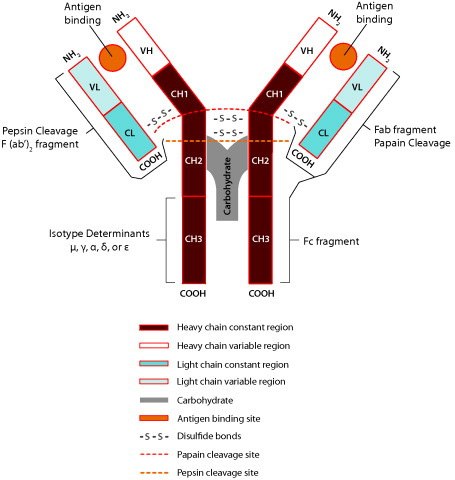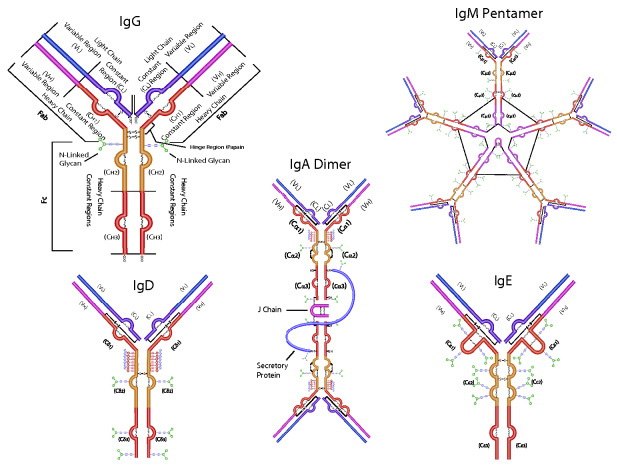Antibody Basics
Basic Antibody Structure
Immunoglobulins (Igs) are produced by B lymphocytes and secreted into plasma. The Ig molecule in monomeric form is a glycoprotein with a molecular weight of approximately 150 kDa that is shaped more or less like a Y. Basic structure of the Ig monomer (Figure 1) consists of two identical halves connected by two disulfide bonds. Each half is made up of a heavy chain of approximately 50 kDa and a light chain of approximately 25 kDa, joined together by a disulfide bond near the carboxyl terminus of the light chain. The heavy chain is divided into an Fc portion, which is at the carboxyl terminal (the base of the Y), and a Fab portion, which is at the amino terminal (the arm of the Y). Carbohydrate chains are attached to the Fc portion of the molecule. The Fc portion of the Ig molecule is composed only of heavy chains. Fc regions of IgG and IgM can bind to receptors on the surface of immunomodulatory cells such as macrophages and stimulate the release of cytokines that regulate the immune response. The Fc region contains protein sequences common to all Igs as well as determinants unique to the individual classes. These regions are referred to as the constant regions because they do not vary significantly among different Ig molecules within the same class. The Fab portion of the Ig molecule contains both heavy and light chains joined together by a single disulfide bond. One heavy and one light chain pair combine to form the antigen binding site of the antibody. Each Ig monomer is capable of binding two antigen molecules.

Figure 1.Basic Immunoblobulin structure.

Figure 2.Main Immunoglobulin classes.
Class identity is determined by class-specific sequences in the Fc region of the heavy chain which are designated by Greek letters corresponding to the Ig letter designation: alpha-IgA, delta-IgD, epsilon-IgE, gamma-IgG, mu-IgM. Light chains are universal among immunoglobulins and occur as two types — kappa or lambda. These are usually designated by the Greek letters kappa and lambda. Refer to Table A and Table B for Human and Mouse Immunoglobulin Properties, respectively.
* Light chains are present on all Immunoglobulin classes. In humans, k. chains are found 67% of the time, and λ chains are found 33% of the time. For ratios in other species see Immunoglobulin Light Chain Ratios table.
The ratio of kappa to lambda found in the Ig population varies by species. Refer to Table C.
References
To continue reading please sign in or create an account.
Don't Have An Account?